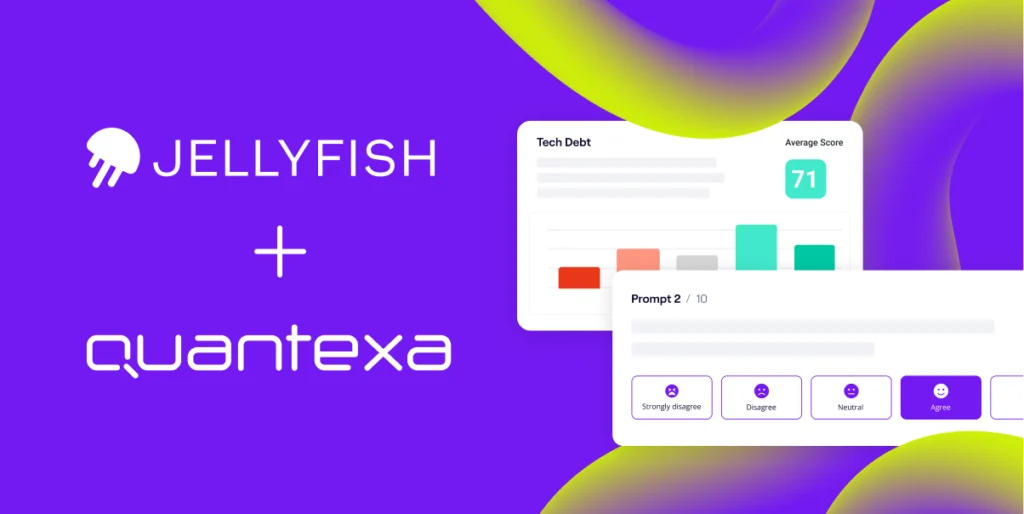From complicated spreadsheets to a user-friendly platform
Founded in 2011, nCino is a financial technology company that offers a cloud banking platform to financial institutions worldwide. After a decade of steady growth, nCino went public in 2020 — the company’s global headcount of more than 1,650 employees also includes a robust team of more than 300 engineers.
As nCino grew, the engineering organization tried to keep pace using spreadsheets for reporting and dashboards. These spreadsheets limited the nCino team in two crucial areas: they lacked the ability to offer useful insights and were also inaccessible to those outside the engineering team. Only a select few engineering team members could adjust and maintain the spreadsheets, limiting their usefulness to the organization as a whole.
The nCino engineering organization was looking for a new tool for engineering management. They chose Jellyfish because of its potential to deliver insights beyond the engineering team.
Steve Gardanier Vice President of Engineering, nCinoWith Jellyfish, it felt less like an engineering-only tool. It was something product managers and executives could use as well.
This tool brought not only the insights from Github and Jira, but also the ability for product managers to see their epic cycle times and the value and projected costs of what they’re building.”
nCino adopted Jellyfish at a critical business moment. After years of rapid, industry-wide growth, the engineering organization had to choose whether or not to invest in a new engineering management solution as the market showed signs of cooling down. For nCino’s leadership, this was a reason to invest in Jellyfish sooner rather than later. “Our executives wanted to make sure we’re getting everything we can out of our development organization,” said Gardanier. “It’s one of the most expensive parts of the organization; you want to make sure you’re getting the most out of it.”
Building trust with data
Even in its earliest days, nCino had the ambitious goal of becoming a world-class software organization. It used spreadsheets to track trends across individual and team performance and set concrete goals for allocations and cycle times. But as personnel shifted and the company aimed to project the results of those changes, the team found it too complicated to maintain its spreadsheets.
The nCino team recognized that Jellyfish would allow them to set new expectations, particularly around testing and quality assurance. Instead of investing in individual employees who could handle QA, each team took ownership and responsibility for the quality of their code.
“We started having these conversations, and every week I would pull a report out of Jira,” said Casey Williams, Senior Manager of Software Engineering at nCino. “We were able to get that pulled into Jellyfish, saving me two to three hours per week. Being able to take that back to teams and show trends and the impacts of changes has allowed us to improve our issue cycle time by 20%.”
The shift to an engineering management platform also led to some concerns from engineers. In what ways would the data be used to evaluate their performance? Instead of using engineering data for performance management, the nCino team used it to validate what was happening in the engineering teams and build trust across the organization. “Data is scary,” said Williams. “There’s a lot of lack of trust… I feel like we’ve seen the opposite.”
Casey Williams Senior Manager of Software Engineering, nCinoIt’s helped build the trust between leadership and developers. Instead of weaponizing data, we use it to tell a story and make decisions on how to best allocate resources.
Jesse Croxford, Developer at nCino, shared that “Jellyfish has helped me identify areas to work on and discuss in 1:1’s with my manager. I have a personal ceremony of doing a weekly, monthly, and quarterly retro reflecting on a handful of things I’m trying to measure about my work. Jellyfish gives good insights into the ‘day to day’ things that I can then compare to metrics I pull from other places.”
Some of the things Jesse typically asks in Jellyfish include:
- Am I spending too much time on day to day work and not enough time on other things?
- Am I getting too distracted by other things and not keeping pace with day to day work?
- As a dev in a few code owner groups, I probably should be doing more code reviews than most. Do my metrics match that assumption?
Enabling continuous improvement
For the nCino team, the goal was to focus on outcomes rather than outputs — ensuring that engineering work delivers value to the customer rather than optimizing metrics for optimization’s sake. The company’s engineering managers began using Jellyfish to inform team-level experiments and improvements.
“We ask each team lead to find something they’re struggling with and start tracking it in Jellyfish,” said Williams. “A month later, they report back to the group on what they were tracking and the stories on what they did about it. It’s a way to quickly collect data and learn about which decisions led to positive results, and that’s then being shared across a number of team leads so they can all learn and grow together.”
“Jellyfish makes it possible for our engineering teams to work with confidence,” said Gardanier. “The alignment we gain across the teams is automated; we don’t have to be engaged in tiny discussions.”
Steve Gardanier Vice President of Engineering, nCinoThe best teams are those that are constantly improving. If you’re always getting better, you’re a world-class team.
Expanded adoption and cultural shifts
One of the most striking benefits of Jellyfish has been the engagement of key stakeholders on engineering metrics. Instead of complicated, difficult-to-understand spreadsheets, Jellyfish offers tools that deliver immediate value to everyone from product managers to C-suite leaders.
“Empowering leaders from different roles has been huge,” said Brooks Folk, Engineering Enablement Leader at nCino. “No matter the position you’re in at nCino — the visualizations are huge for us. To be able to see that and quickly change it over a timeframe, that has been invaluable for various roles throughout our organization.”
“Our CEO is quoting specific engineering stats, saying ‘we’re 80% more productive than we were a year ago,’” said Gardanier. “He wouldn’t have been able to say things like that before. You can tell he loves that kind of improvement. To be able to specifically detail the percentage gained us a lot of capital within our company.”






